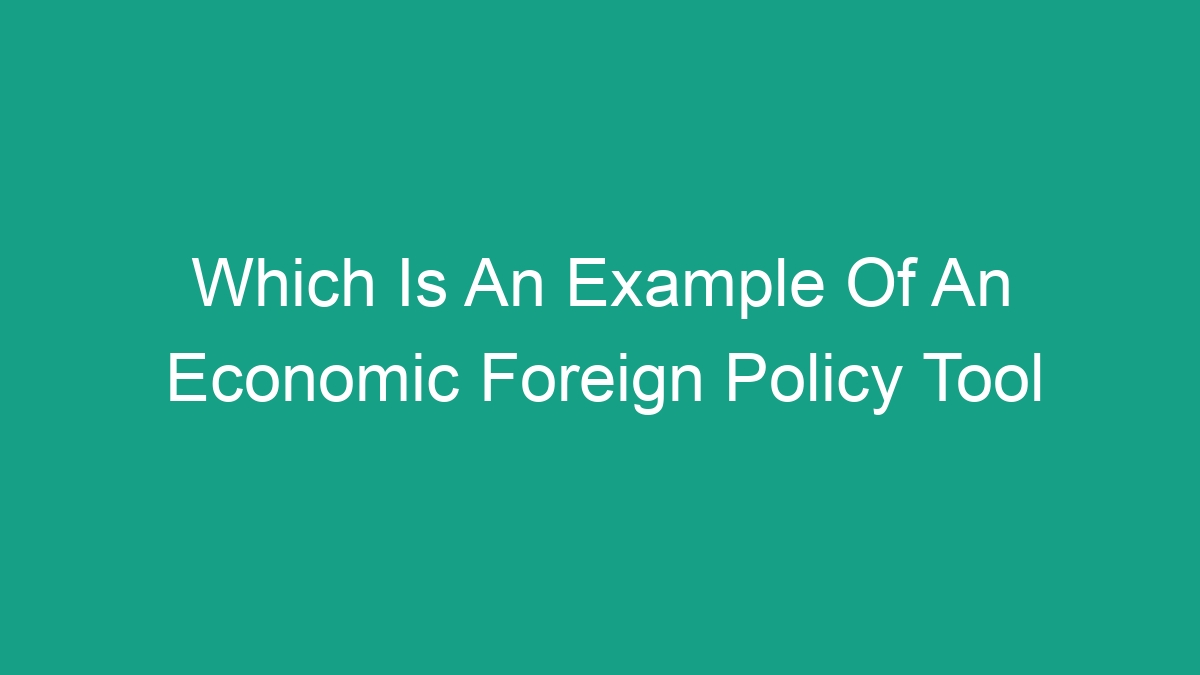
When it comes to international relations and diplomacy, countries often use various tools to achieve their economic foreign policy objectives. These tools can range from trade agreements and sanctions to foreign aid and investment incentives. In this article, we will explore various examples of economic foreign policy tools that countries use to pursue their strategic economic interests on the global stage.
Trade Agreements
Trade agreements are one of the most common economic foreign policy tools used by countries to promote mutually beneficial trade relationships with other nations. These agreements typically involve the reduction or elimination of tariffs, quotas, and other trade barriers to facilitate the flow of goods and services between the signatory countries.
Examples of trade agreements include:
- North American Free Trade Agreement (NAFTA): This agreement, which was later replaced by the United States-Mexico-Canada Agreement (USMCA), aimed to promote trade and investment among the three North American countries.
- European Union (EU) Trade Agreements: The EU has signed various trade agreements with countries and regions around the world to facilitate trade and economic cooperation.
- Comprehensive and Progressive Agreement for Trans-Pacific Partnership (CPTPP): This agreement aims to promote trade and economic integration among its member countries in the Asia-Pacific region.
Sanctions
Sanctions are a widely used economic foreign policy tool to exert pressure on a targeted country and influence its behavior. Sanctions can take various forms, including trade restrictions, financial penalties, and arms embargoes. The goal of sanctions is to compel the targeted country to change its policies or actions in line with the interests of the imposing country or coalition.
Examples of sanctions include:
- United Nations Sanctions on North Korea: The UN has imposed various sanctions on North Korea in response to its nuclear weapons and ballistic missile programs.
- United States Sanctions on Iran: The US has implemented sanctions on Iran to pressure the country to abandon its nuclear program and support for international terrorism.
- European Union Sanctions on Russia: The EU has imposed sanctions on Russia in response to its annexation of Crimea and its role in the conflict in Ukraine.
Foreign Aid
Foreign aid is another economic foreign policy tool used by countries to provide financial assistance, technical support, and humanitarian aid to other nations. Foreign aid can be used to promote economic development, alleviate poverty, and address global challenges such as health crises and natural disasters. It can also serve as a means to build diplomatic relationships and influence the policies of recipient countries.
Examples of foreign aid programs include:
- United States Agency for International Development (USAID): USAID provides foreign assistance to support sustainable development and humanitarian efforts in various countries around the world.
- European Union Humanitarian Aid and Civil Protection (ECHO): ECHO provides humanitarian aid to crisis-affected countries and regions, focusing on the most vulnerable populations.
- China’s Belt and Road Initiative: China has launched a massive infrastructure and economic development initiative aimed at building connections and fostering cooperation with countries across Asia, Africa, and Europe.
Investment Incentives
Investment incentives are economic foreign policy tools used by countries to attract foreign direct investment (FDI) and stimulate economic growth. These incentives can include tax breaks, subsidies, infrastructure development, and streamlined regulatory processes to make the host country more attractive to foreign investors.
Examples of investment incentives include:
- Singapore’s Investment Promotion Strategy: Singapore offers various incentives to attract foreign investment, including tax exemptions, grants, and access to government-supported infrastructure and services.
- Foreign Investment Promotion in India: India has implemented policies to attract FDI in sectors such as manufacturing, infrastructure, and technology, offering incentives such as tax benefits and simplified regulatory processes.
- Germany’s Economic Development Programs: Germany provides incentives for foreign companies to invest in research and development, innovation, and industrial projects through grants, loans, and partnership programs.
Conclusion
Each of these economic foreign policy tools plays a significant role in shaping the economic relationships and interactions between countries on the international stage. From trade agreements and sanctions to foreign aid and investment incentives, these tools are essential for countries to pursue their economic interests, promote economic development, and influence the behavior of other nations.
It is crucial for policymakers and diplomats to understand the potential impact and effectiveness of these tools in achieving their foreign policy objectives while also considering the broader geopolitical and economic implications of their decisions.
As the global economy continues to evolve and interconnect, economic foreign policy tools will remain integral to international relations and the pursuit of strategic economic interests on the world stage.



